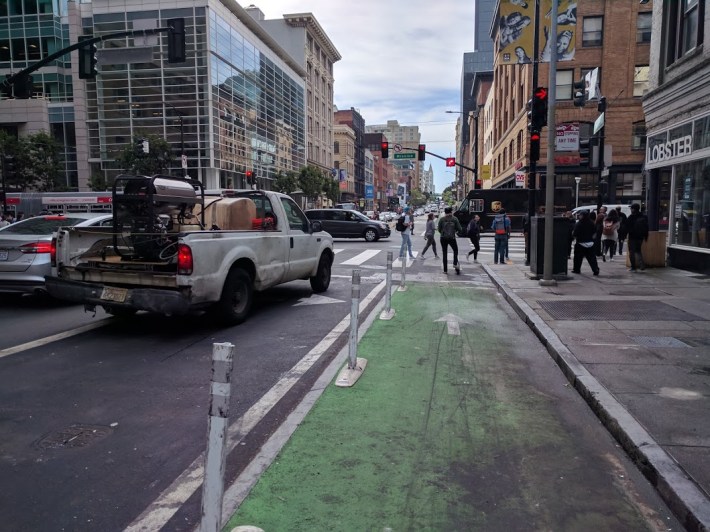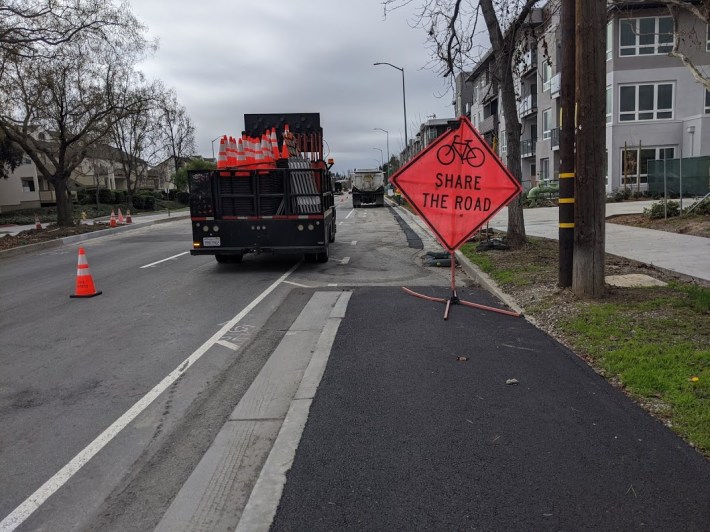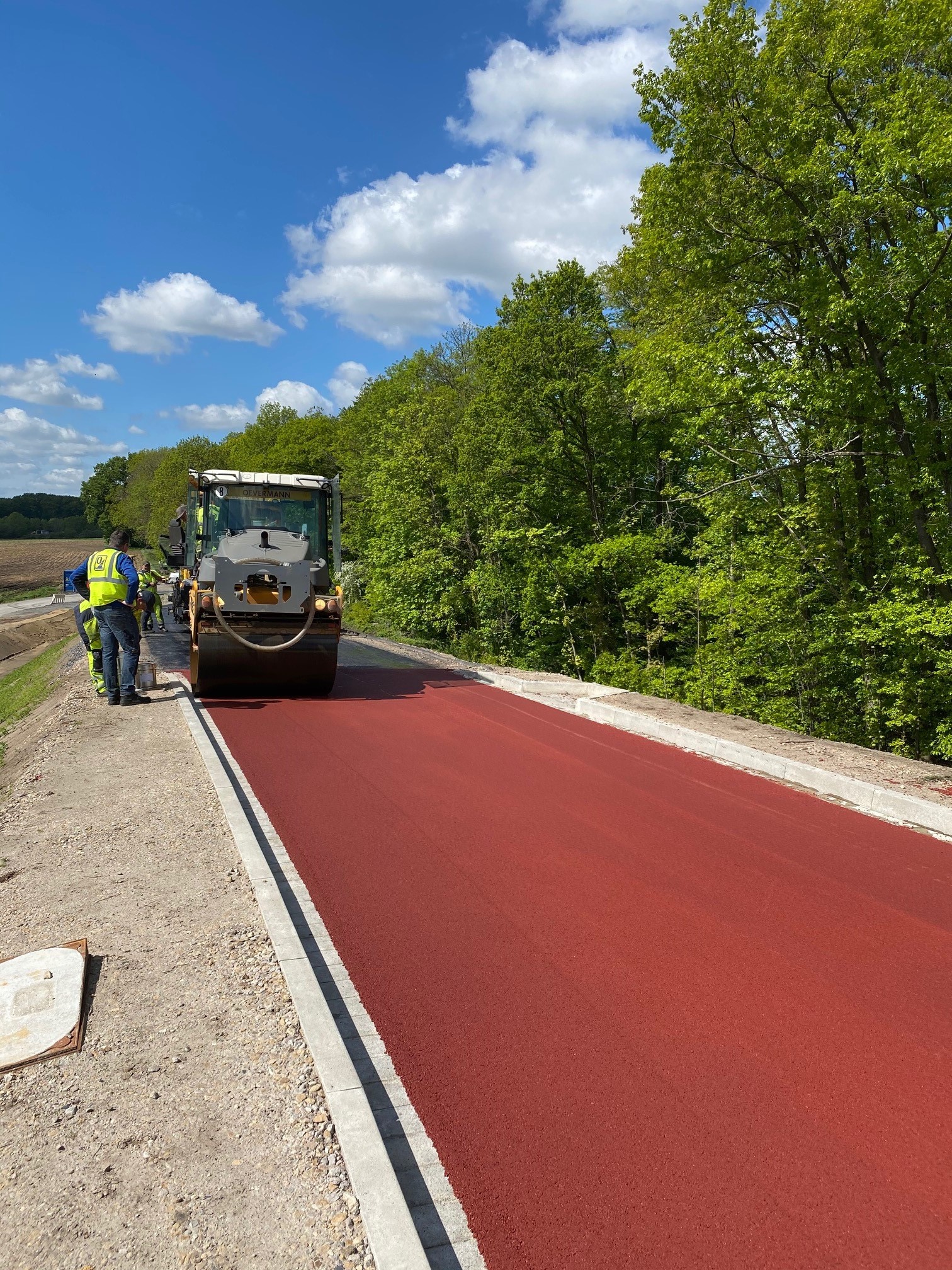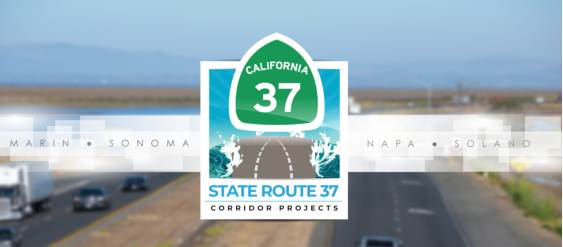Bike paths go in. Green paint is applied to the asphalt. Ribbons are cut. Speeches given. Everything looks great. And then a few years pass, and the paint is all but worn away.
That progression has some wondering why the Bay Area doesn't take another page from the Dutch handbook: bike lanes in the Netherlands are paved with colored asphalt, rather than a layer of paint. Since the pigment is mixed into the asphalt itself, the color isn't lost as friction wears away the surface.
Here's a tweet from an SFMTA planner with a close-up of the material used in the Netherlands:
It doesn't have to be red, of course, but "using integral-colored asphalt, as the Dutch do, makes more sense than painting the surface. Painting the surface is cheap to install but wears very poorly," wrote Livable Cities' Tom Radulovich.
From the International Coloured Asphalt Foundation (yes, there is such a thing):
Coloured asphalt is a durable solution with similar mechanical resistance as normal asphalt, improves safety due to attention and separation of traffic functions and offers a wide variety of landscaping possibilities. Application areas are bus lanes, speed bumps, bicycle lanes, parking areas, squares, playgrounds and footpaths.
Coloured asphalt consists of clear (transparent) binder, colour pigments and aggregates. Coloured aggregates are recommended to achieve a durable colour. By carefully selecting the right configuration of binder, pigments and aggregates, every desired colour is possible!
Streetsblog reached out to OakDOT and SFMTA to find out why they use paint or thermoplastic (colored plastic melted on top of the asphalt) rather than colored asphalt. Streetsblog will update this post if they reply; however, a source at one of the agencies said he's not aware of colored asphalt being considered for any street projects.

Nobody argues that colored asphalt wouldn't be a superior, longer-lasting treatment (note the above photo of the bike lane on 2nd in San Francisco, shortly after it was painted). However, "given that even continuous green thermoplastic is getting cut out of bikeway projects here due to its expense (it can add up: $8 per square foot for 6’ bike lanes both ways over a mile-long project would cost half a million dollars), I think an even costlier treatment would be very unlikely," wrote Bike East Bay's Robert Prinz in an email to Streetsblog.
"Berkeley had conversations about colored asphalt many years ago and Public Works quickly nixed the idea due to costs," added the Dave Cambell, also from Bike East Bay.
A 2016 study done by Oklahoma's DOT estimated that paint costs about $3.60 per square foot with labor, while adding a layer of colored asphalt was $13. Presumably, similar ratios would apply in the Bay Area. Of course, streets eventually need to be resurfaced with new asphalt whether or not they have been colored, and the Oklahoma study noted that colored asphalt was only marginally more expensive than conventional asphalt. The takeaway: if applying fresh asphalt as part of its project, use colored asphalt for bike or transit lanes. The lower maintenance costs compared to paint will save money.

However, in the Bay Area, even in major repaving projects that include bike lanes, such as Telegraph in Oakland, the Presidio's project, or Fremont's redesign of Walnut, pictured above, cities continue to put down conventional asphalt then come back and apply a layer of paint afterward. The paint then wears off and has to be redone. "The city generally does a poor job balancing initial capital cost against future operating, maintenance, and replacement costs," said Radulovich.
Paint and thermoplastic "is easier to remove and reapply if changes to street layout need to be made, so it's a more flexible/nimble way of demarcating space for people who bike," said the San Francisco Bicycle Coalition's Brian Wiedenmeier. But if cities are sure enough of their configurations to be laying new asphalt, mixing pigment into it just makes more sense. "Often spending a little more at the outset saves a lot more over time," said Radulovich. "We need to think about leaving fewer messes for people to clean up later."






